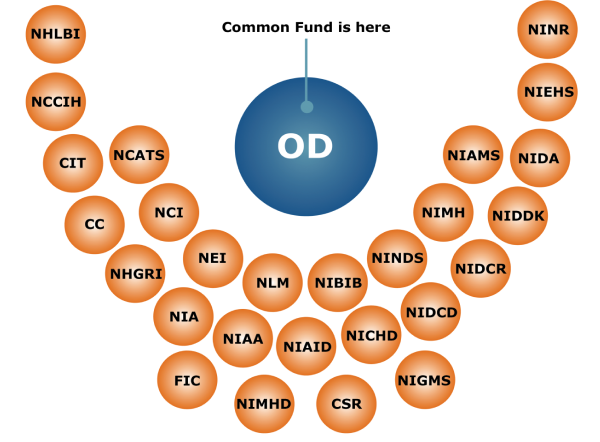Who We Are and What We Do
Watch the "What is the NIH Common Fund" video to learn more about our mission and the innovative programs we support.
Who We Are
The NIH Common Fund is a funding entity within the NIH that supports bold scientific programs that catalyze discovery across all biomedical and behavioral research. These programs create a space where investigators and multiple NIH Institutes, Centers, and Offices collaborate on innovative research expected to address high priority challenges for the NIH as a whole and make a broader impact in the scientific community.
What We Do
- We make substantial investments in time-limited, goal-driven programs in order to change significantly the trajectory of biomedical research
- Our programs accelerate emerging science, enhance the biomedical research workforce, remove research roadblocks, and support high-risk high-reward science in ways that no other entity is likely or able to do
- We gather diverse input from NIH leadership, staff, and the broad biomedical research community to plan our programs
- We assemble consortia of multidisciplinary, innovative research who collaborate to tackle a shared, ambitious goal
- We manage our programs in partnership with nominated experts from the NIH Institutes and Centers
- We design our programs so that each deliverable will spur subsequent biomedical advances that otherwise would not be possible without our strategic investment
The goals of Common Fund programs align with three general categories, each outlined in the graphic below. To see the Programs listed under our goals, click on each of the three categories.
 The NIH Common Fund is managed by the Office of Strategic Coordination (OSC) within the Division of Program Coordination, Planning, and Strategic Coordination in the NIH Office of the Director (OD). The Office of the Director is the central office at NIH, and is responsible for setting policy for NIH and for planning, managing, and coordinating the programs and activities of all the NIH components.
The NIH Common Fund is managed by the Office of Strategic Coordination (OSC) within the Division of Program Coordination, Planning, and Strategic Coordination in the NIH Office of the Director (OD). The Office of the Director is the central office at NIH, and is responsible for setting policy for NIH and for planning, managing, and coordinating the programs and activities of all the NIH components.
All NIH Common Fund and Venture programs meet a series of criteria in order to support the Common Fund mission.
Common Fund criteria
- Transformative – strong potential for exceptionally high and broadly applicable impact in biomedical/behavioral research
- Catalytic – time-limited investments of 10 years or less, designed to capitalize on new scientific knowledge or breakthroughs to accelerate and enable subsequent research
- Goal-driven – include defined goals to develop specific deliverables (such as new knowledge, data sets, resources, methods, or technologies)
- Synergistic – advance the missions of multiple NIH Institutes, Centers, and Offices (ICOs), leverage expertise from multiple ICOs, and accelerate research relevant to multiple diseases and conditions
- Novel – pursue innovative solutions to specific scientific challenges important to the NIH mission but that no other entity is likely or able to address
Venture Program criteria
- Bold – daring investments with potential for significant, outsized impact
- Nimble – can be implemented rapidly in response to scientific opportunity
- Focused – limited to three years, up to $5 million annually to invest in a clearly defined research topic



